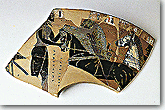



   |
|
|
|
A typical expression of individualism making its appearance in the Archaic period is the declaration of his identity by the artist in his work. These signatures, particularly well-known from the ceramic vessels of the time and possible thanks to the rediscovery of writing, take the two forms egraphsen and epoiesen; or when the vessel speaks as if in person: m'egraphsen kai m'epoiesen. The first indicates the painter who painted the vessel; the second, the potter who made it. Thanks to the developed self-evaluation and pride of various artists, various masterpieces of Attic vase-painting emerge from obscurity; at the same time, we have the opportunity to get information about the organization and functioning of the workshops of classical Athens. Thus such names have come down to us as: Sophilus, Clitias, Ergotimus, Lydus, Amasis, Exekias, Nicosthenes, and Euphronius. |
  |
In the literature of the time, the creator as individual went beyond the tradition of a simple invocation to the Muses, and did not hesitate to refer extensively to autobiographical elements, subjective judgments, and personal feelings. Hesiod complained about the lack of control over power (Works and Days 34-41, 174-179, 263-266); Solon referred with genuine pride to all he had done to lighten the lot of the poor and weak (Elegeia 5-6, Iamboi 36); Sappho hymned her loves (Diehl 40-41, 48, 50, 114, 137); and Archilochus bewailed the fate that took him as colonist to Thasos (frag. 20, 21A, 52, 103). Through lyric poetry, the use of the first person lent to the 'I' the confidence befitting a model of universal range, able to advance the specific and subjective to an equivalent and a rival of the general and the socially well-established. |
|
| |
|
Note: Click on a picture for a brief description. | |